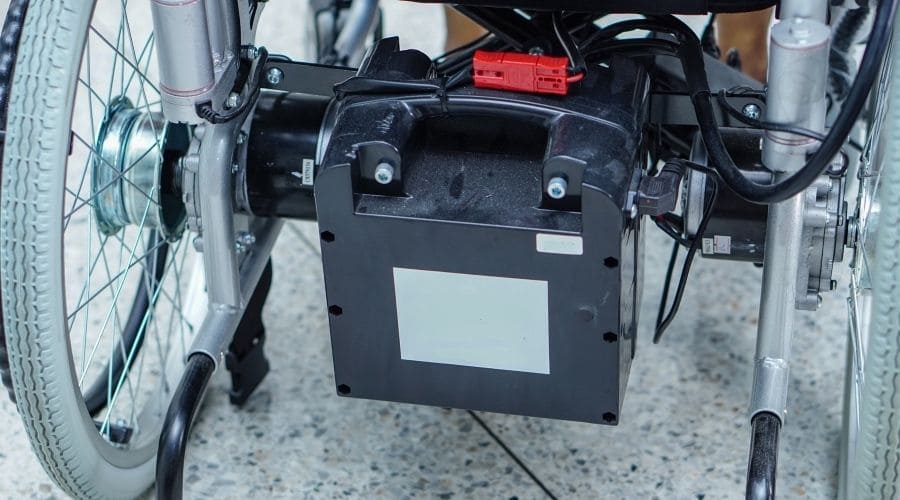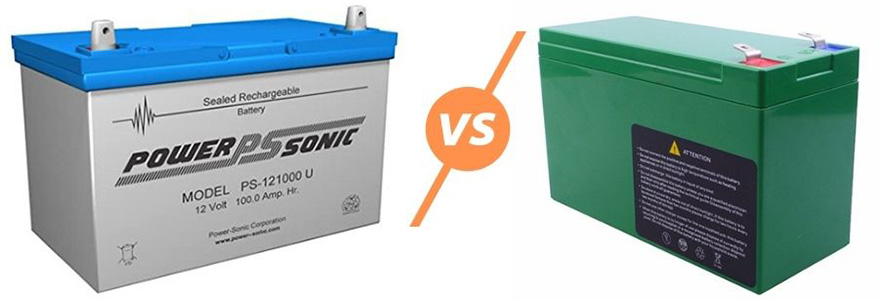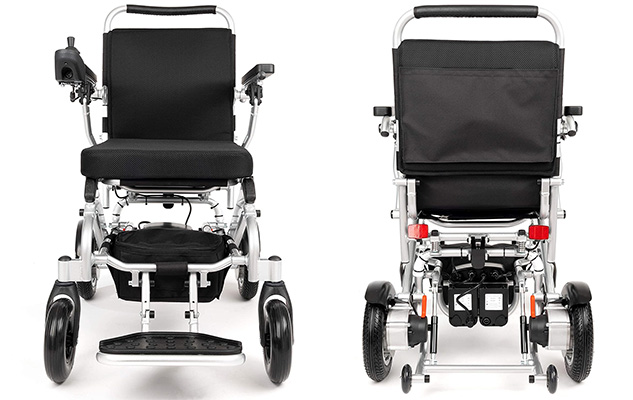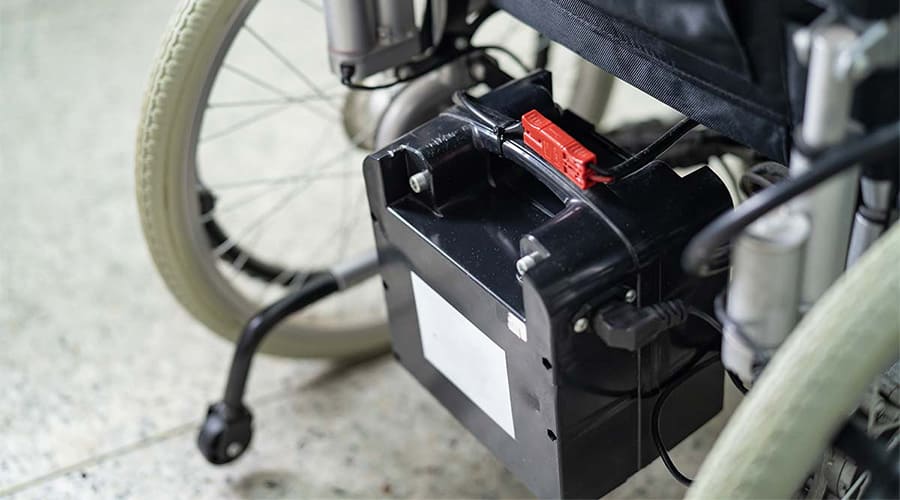Lithium batteries could double the driving range for power wheelchairs compared to a typical deep cycle battery.
In recent years the hype behind the lithium-ion battery continues to increase in consumer electronics as we are seeing them integrated into laptop computers, power tools, and hybrid vehicles.
But why isn’t it immediately available in power wheelchairs, and when will it be? In this article, we answer all of your burning questions. Ready, set, charge!
What is a Lithium-Ion Wheelchair Battery?

The term “lithium-ion” is often misused. It is a separate battery technology classed in the category of lithium batteries.
One important fact to note about the lithium-ion battery is that it is one of the least stable lithium-derived varieties prone to exploding when exposed to heat.
There have been some incidents involving lithium-ion batteries, and certain sizes are also prohibited on airplanes.
Since lithium-ion batteries are still being finetuned, a similar variety developed by universities and private industries called “lithium iron phosphate” has been evolving to meet technological demand.
Compared to traditional types of batteries, lithium iron phosphate is safer, longer-lasting, more discharge/charge efficient, and has the ability to deep cycle with consistent power.
Many advanced technological gadgets are powered with this type of lithium battery, including Segway scooters and DeWalt power tools.
In other words, lithium-ion is more or less the unicorn of the battery world, while the safer lithium iron phosphate is most likely the real MVP you’ve heard.
Lead Acid/AGM Batteries vs. Electric Wheelchair Lithium Battery

Electric wheelchairs are powered with deep cycle AGM (absorbed glass mat) or gel sealed lead-acid batteries.
These wheelchair battery types are cheaper and safer than lithium-ion but are heavier and require more maintenance.
When the juice is running low, a wheelchair with this type of battery will slow down significantly until it runs out.
They are designed to last around 10 miles per charge, with a total lifespan of one to two years. Of course, this is dependent on how often the wheelchair is used, the weight of the wheelchair, and the amount of wear n’ tear it sustains.
Lithium-ion, on the other hand, offers innumerable benefits. It’s smaller, lighter, and lasts around 21 miles on a single charge. It also runs full power until the battery dies instead of gradually slowing down.
This would give wheelchair users the ability to explore more without the inconvenience of having to mind the battery as much.
So, why isn’t lithium technology being targeted at the wheelchair industry?
There are a few lightweight electric folding wheelchairs with lithium batteries, but as mentioned above, it’s still a tricky technology. No one wants their wheelchair to go up in flames, right?
Plus, lead-acid and AGM batteries work well for power chairs. The heavier design of these batteries enhances a lower center of gravity, improving overall stability.
Still, lithium iron phosphate batteries are supposedly safer and prove their efficiency with various consumer products. On average, they are 33% lighter, last up to five years, and output twice the amount of power compared to a conventional battery.
To better understand the lithium mystery, we’ll discuss this complex variant in more detail in the next section.
The Challenges of a Lithium Wheelchair Battery

The answer to the lithium wheelchair battery saga comes down to three things:
Testing
Lithium iron phosphate batteries have proven safe and promising in many of the latest products. Still, the key difference here is that none of the products come from the medical industry.
That’s because battery testing in medical devices is ongoing, and wheelchairs fall into this category.
With that being said, we are beginning to see lithium nipping at the edges of the wheelchair market. Lithium iron phosphate batteries are being used in lifts and some folding wheelchairs, as mentioned.
But it will take some time until we see it in a self-confined device like a power wheelchair, where reliability and safety are paramount.
Therefore, extensive testing must continue to smooth out every issue before it hits the wheelchair market with confidence.
Compatibility
Most power wheelchair electrical systems aren’t designed to be compatible with lithium iron phosphate batteries.
These batteries feature different charging requirements and voltages than lead-acid batteries.
If used with current wheelchairs, it can lead to electrical issues, whether it be a simple inaccurate battery gauge reading or a more serious matter, such as overheating.
In other words, current power wheelchair designs must be upgraded to accommodate lithium-ion batteries with ease.
Cost
Finally, lithium iron phosphate batteries are significantly more expensive than lead-acid variations.
While a pair of Group-24 lead-acid batteries cost around $400, a similarly-sized pair of lithium iron phosphate batteries cost around $3,500.
This is tough for consumers to afford, especially when factoring in the cost of maintenance and other basic wheelchair necessities.
As well, many consumers rely on insurance to help cover the costs of a power wheelchair, and it could be a hassle trying to get insurers to agree to a pricey lithium-ion battery.
Paying $3,500 for batteries is simply out of the ballpark for most, especially when affordable lead-acid batteries usually suffice for getting around the house or neighborhood.
Will We See a Lithium Battery Wheelchair in the Future?

Feeling like your battery dreams are dashed? Don’t worry because battery technology is one of the fastest-growing technological trends worldwide.
As consumers are making more environmentally conscious buying decisions, this is driving demand for safer, cost-effective battery technologies.
There’s no doubt that battery advancements are moving towards the mobility market. As consumers learn more about the benefits of lithium-ion and as testing continues, it’s apparent that the advantages it offers surpass traditional batteries.
In this way, it’s not a question of whether lithium battery wheelchairs will happen, but merely a matter of when we’ll get our hands on the technology.
The good news is, it seems to be getting closer every day.
Final Thoughts on Lithium Batteries and Wheelchairs
As power wheelchair technology continues to evolve, a common question that pops up is when lithium batteries will make their way into the mobility industry.
It’s no secret that these batteries are more advanced than the traditional types, giving users the freedom to travel farther and longer on a single charge.
But it all comes down to time. There’s still plenty of work and testing to be done on the safety and efficiency of lithium-ion batteries. And while we are seeing them powering electric cars and power tools, the medical devices industry has yet to give the green light.
Resources & References:
- Better Batteries, Better Wheeling, New Mobility.
- Wheelchair Batteries: Driving Cycles and Testing, Rehab Research.
- A Review of Lithium-Ion Battery Safety Concerns, ScienceDirect.